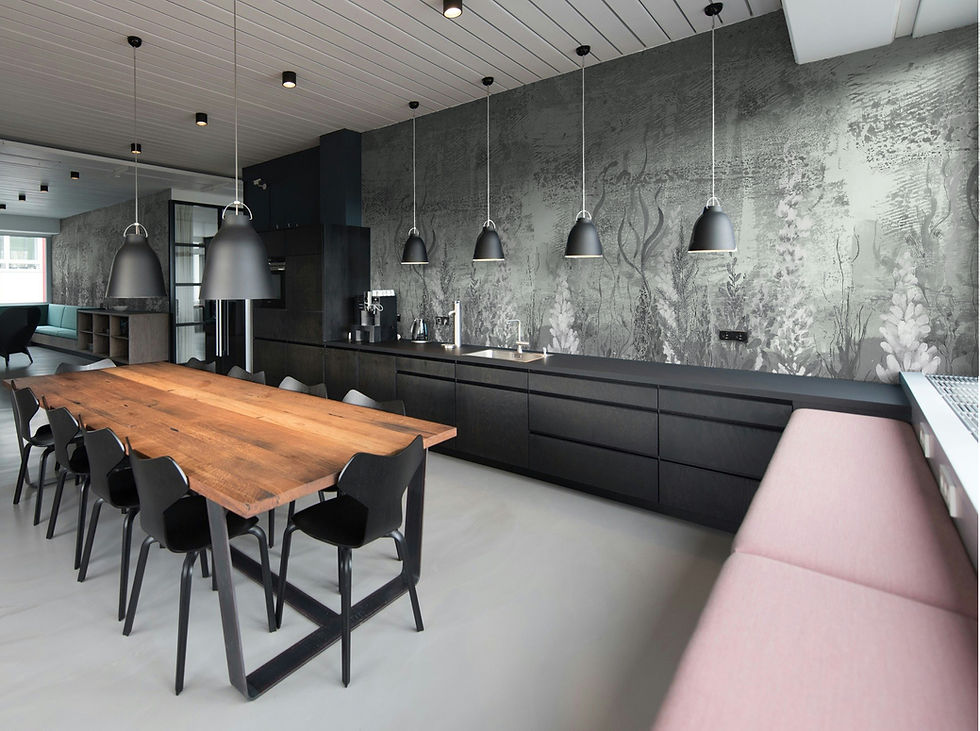Beyond Aesthetics: How to Choose the Right Wallcovering for a Commercial Project in the US
- Guillermo
- May 25
- 3 min read
Updated: Nov 12
For commercial spaces across the U.S. – from dynamic corporate offices and bustling hospitality venues to serene healthcare facilities and vibrant retail environments – wallcoverings play a far more critical role than simple aesthetics.
Unlike residential wallpaper, commercial wallcoverings must meet stringent performance standards, adhere to strict building codes, and withstand the demands of heavy traffic, all while reflecting brand identity and creating a specific ambiance.
So, when embarking on a commercial project, how do architects, interior designers, and developers ensure they choose the right wallcovering? It’s a strategic decision that balances durability, safety, functionality, and design.
1. Durability & Performance: Built to Withstand the Daily Grind
Commercial spaces endure significantly more wear and tear than homes. This makes durability the paramount concern.
Type I vs. Type II Vinyl Wallcoverings: These are the workhorses of commercial design.
Type I (Light Duty): Suitable for areas with moderate traffic, like hotel rooms, private offices, or patient rooms. They offer good resistance to abrasions and minor impacts.
Type II (Heavy Duty): Essential for high-traffic zones such as hotel lobbies, corridors, retail stores, public restrooms, and corporate common areas. They are highly resistant to abrasion, tearing, and can withstand frequent cleaning.
Cleanability: Commercial wallcoverings must be easy to clean and maintain, often requiring specific cleaning protocols. Look for options that are scrubbable and resistant to common commercial cleaning agents.
Longevity: Investing in high-performance materials means fewer replacements, saving on long-term costs and minimizing disruption to business operations.
2. Fire Ratings & Building Codes: Safety is Non-Negotiable
This is perhaps the most critical difference between residential and commercial wallcoverings in the US. Fire safety ratings are mandated by building codes to ensure public safety.
ASTM E84 (NFPA 255): This is the standard test method for surface burning characteristics of building materials. For most commercial applications, wallcoverings must achieve a Class A fire rating. This indicates they have low flame spread and smoke development, significantly slowing the spread of fire and giving occupants more time to evacuate.
Compliance: Always verify that the chosen wallcovering meets local and national fire codes for the specific commercial occupancy type (e.g., assembly, business, healthcare). Reputable suppliers will provide clear documentation of their products' fire ratings.
3. Functionality: Enhancing the Environment
Beyond looks, wallcoverings can contribute to a space's overall functionality.
Acoustical Wallcoverings: In open-plan offices, restaurants, or conference rooms, noise control is crucial. Specialized acoustical wallcoverings absorb sound, reducing echo and creating a more comfortable and productive environment. They offer a stylish solution to a common commercial challenge.
Thermal Insulation: Some thicker wallcoverings can provide a minor degree of thermal insulation, contributing to energy efficiency.
4. Aesthetics & Brand Identity: More Than Just a Backdrop
While functional, commercial wallcoverings are also powerful tools for design and branding.
Brand Reinforcement: In retail or corporate settings, wallcoverings can visually reinforce a brand's identity, color palette, and ethos, creating a memorable experience for clients and employees.
Atmosphere Creation: From the calming textures in a spa to the vibrant patterns in a boutique hotel lobby, wallcoverings establish the desired mood and atmosphere.
Custom Murals: For a truly unique statement, custom commercial murals can transform an entire wall into a branded art piece, a local landmark, or an inspiring visual narrative. This is perfect for lobbies, feature walls, or large communal areas.
High-End Finishes: Materials like wood veneers or sophisticated large-scale patterns elevate the perceived value and luxury of a space, crucial for hospitality, executive offices, or high-end retail.
5. Installation & Project Complexity: The Need for Expertise
Commercial projects often involve larger surface areas, unique architectural features, and tighter timelines.
Experienced Installers: The choice of wallcovering must also consider the feasibility and expertise required for installation. Complex patterns, large murals, or specialized materials like wood veneers demand installers highly experienced in commercial applications to ensure a flawless finish and efficient project completion.
Partnering for Commercial Wallcovering Success
Choosing the right wallcovering for a commercial project in the US is a multifaceted decision that requires careful consideration of durability, fire safety, functionality, and aesthetic impact. It's about selecting materials that will not only look stunning but also perform under pressure and adhere to all regulatory requirements.
At The Wallpaper Company, we understand the unique demands of commercial design. We specialize in providing high-performance vinyl wallcoverings (Type I & Type II), acoustical wallcoverings, custom murals for branding, and exquisite wood veneers, all with guaranteed fire ratings. Our expertise extends to installation services for complex and large commercial projects, ensuring your vision comes to life seamlessly and to the highest standards.
Partner with us for your next commercial endeavor to ensure a wallcovering solution that is beautiful, compliant, and built to last.





Comments